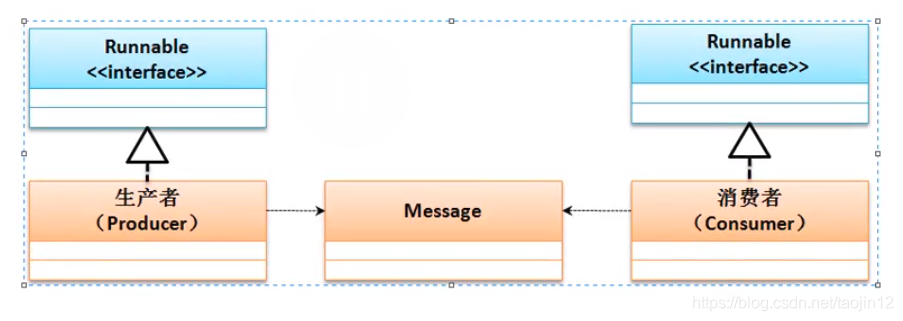生产者与消费者
在多线程的开发过程之中最为著名的案例就是生产者与消费者操作,该操作的主要流程如下:
- 生产者负责信息内容的生产;
- 每当生产者生产完成一项完整的信息之后消费者要从这里取走信息;
- 如果生产者没有完成生产则消费者要等待它完成生产,如果消费者还没有进行消费,则生产者应该等待消费处理完成后再继续生产。
程序的基本实现
可以将生产者与消费者定义为两个独立的线程类对象,但是对于现在生产的数据,可以使用如下的组成:
- 数据一:title = 王建 、 content = 宇宙大帅哥
- 数据二: title = 小高、 content = 猥琐第一人
既然生产者与消费者是两个独立的线程,那么这两个独立的线程之间就需要有一个数据保存的集中点,那么单独定义一个Message类实现数据的保存。
如图:

范例: 程序基本结构
package com.thread;
public class Threademo {
public static void main(String[] args) {
Message msg = new Message();
new Thread(new Producer(msg)).start();
new Thread(new Customer(msg)).start();
}
}
/**
* 中间数据类
*/
class Message{
private String title;
private String content;
public String getContent() {
return content;
}
public String getTitle() {
return title;
}
public void setContent(String content) {
this.content = content;
}
public void setTitle(String title) {
this.title = title;
}
}
/**
* 生产者
*/
class Producer implements Runnable{
private Message msg;
public Producer(Message msg) {
this.msg = msg;
}
@Override
public void run() {
for(int x = 0; x < 100 ; x ++) {
if( x % 2 == 0){
this.msg.setTitle("王建");
try {
Thread.sleep(100);
} catch (InterruptedException e) {
e.printStackTrace();
}
this.msg.setContent("y宇宙大帅哥");
} else {
this.msg.setTitle("小高");
try {
Thread.sleep(100);
} catch (InterruptedException e) {
e.printStackTrace();
}
this.msg.setContent("猥琐第一个人,保持常态");
}
}
}
}
class Customer implements Runnable{
private Message msg;
public Customer(Message msg){
this.msg = msg;
}
@Override
public void run() {
for(int x = 0 ; x < 100 ; x ++){
try {
Thread.sleep(10);
} catch (InterruptedException e) {
e.printStackTrace();
}
System.out.println(this.msg.getTitle() + "," + this.msg.getContent());
}
}
}
通过真个代码的执行,你会发现此时有两个主要问题:
- 问题一: 数据不同步了;
- 问题二: 生产一个取走一个,但是发现了有重复生产和重复取出问题;
解决数据同步
如果要解决问题,首先解决的就是数据同步的处理问题,如果想要解决数据同步最简单的做法就是使用synchronized定义同步代码块或同步方法,于是这个时候对于同步的处理就可以直接在Message类中完成。
范例:解决同步操作
package com.thread;
/**
* 中间数据类
*/
class Message{
private String title;
private String content;
public synchronized void set(String title,String content) {
this.title = title;
try {
Thread.sleep(100);
} catch (InterruptedException e) {
e.printStackTrace();
}
this.content = content;
}
public synchronized String get(){
return this.title + "," + this.content;
}
}
public class Threademo {
public static void main(String[] args) {
Message msg = new Message();
new Thread(new Producer(msg)).start();
new Thread(new Customer(msg)).start();
}
}
/**
* 生产者
*/
class Producer implements Runnable{
private Message msg;
public Producer(Message msg) {
this.msg = msg;
}
@Override
public void run() {
for(int x = 0; x < 100 ; x ++) {
if( x % 2 == 0){
this.msg.set("王建","宇宙大帅哥");
} else {
this.msg.set("小高","猥琐第一个人,保持常态");
}
}
}
}
class Customer implements Runnable{
private Message msg;
public Customer(Message msg){
this.msg = msg;
}
@Override
public void run() {
for(int x = 0 ; x < 100 ; x ++){
System.out.println(this.msg.get());
}
}
}
在进行同步处理的时候肯定需要一个同步的处理对象,那么我们此时肯定要将同步操作交个Message类操作最合适了。这个时候发现数据已经可以正常的保持一致了,但是对于重复操作的问题依然存在。
线程等待与唤醒
如果说现在要想解决生产者与消费者的问题,那么最好的解决方法就是使用等待与唤醒机制。而对于等待与唤醒的机制主要依靠的是Object类中提供的方法处理的。
- 等待机制:
1、死等:public final void wait() throws InterruptedException;
2、设置等待时间:public final void wait(long timeout)throws InterruptedException;
3、设置等待时间:public final void wait(long timeout,int nanos)throws InterruptedException; - 唤醒第一个等待线程:
public final void notify(); - 唤醒全部等待线程:
public final void notifyAll();
如果此时有若干个等待线程的话,那么notify()表示的是唤醒等待第一个等待的,而其他的线程继续等待,而notifyAll()表示唤醒所有等待的线程,哪个线程的优先级高就有可能先执行。
对于当前的问题主要解决应该通过Message类完成处理。
范例:修改Message类
class Message{
private String title;
private String content;
private boolean flag = true; //生产或消费的形式
public synchronized void set(String title,String content) {
if(this.flag == false){
try {
super.wait();
} catch (InterruptedException e) {
e.printStackTrace();
}
}
this.title = title;
try {
Thread.sleep(100);
} catch (InterruptedException e) {
e.printStackTrace();
}
this.content = content;
this.flag = false; // 已经生产过了
super.notify(); //唤醒线程
}
public synchronized String get(){
if(this.flag == true){ //还未生产需要等待
try {
super.wait();
} catch (InterruptedException e) {
e.printStackTrace();
}
}
try {
return this.title + "," + this.content;
} finally {
this.flag = true; // 可以继续生产
super.notify(); //唤醒线程
}
}
}
public class Threademo {
public static void main(String[] args) {
Message msg = new Message();
new Thread(new Producer(msg)).start();
new Thread(new Customer(msg)).start();
}
}
/**
* 生产者
*/
class Producer implements Runnable{
private Message msg;
public Producer(Message msg) {
this.msg = msg;
}
@Override
public void run() {
for(int x = 0; x < 100 ; x ++) {
if( x % 2 == 0){
this.msg.set("王建","宇宙大帅哥");
} else {
this.msg.set("小高","猥琐第一个人,保持常态");
}
}
}
}
class Customer implements Runnable{
private Message msg;
public Customer(Message msg){
this.msg = msg;
}
@Override
public void run() {
for(int x = 0 ; x < 100 ; x ++){
System.out.println(this.msg.get());
}
}
}
这种处理形式就是在进行多线程开发过程中最原始的处理方案,整个的等待、同步、唤醒机制都是由开发者自行通过原生代码实现控制。